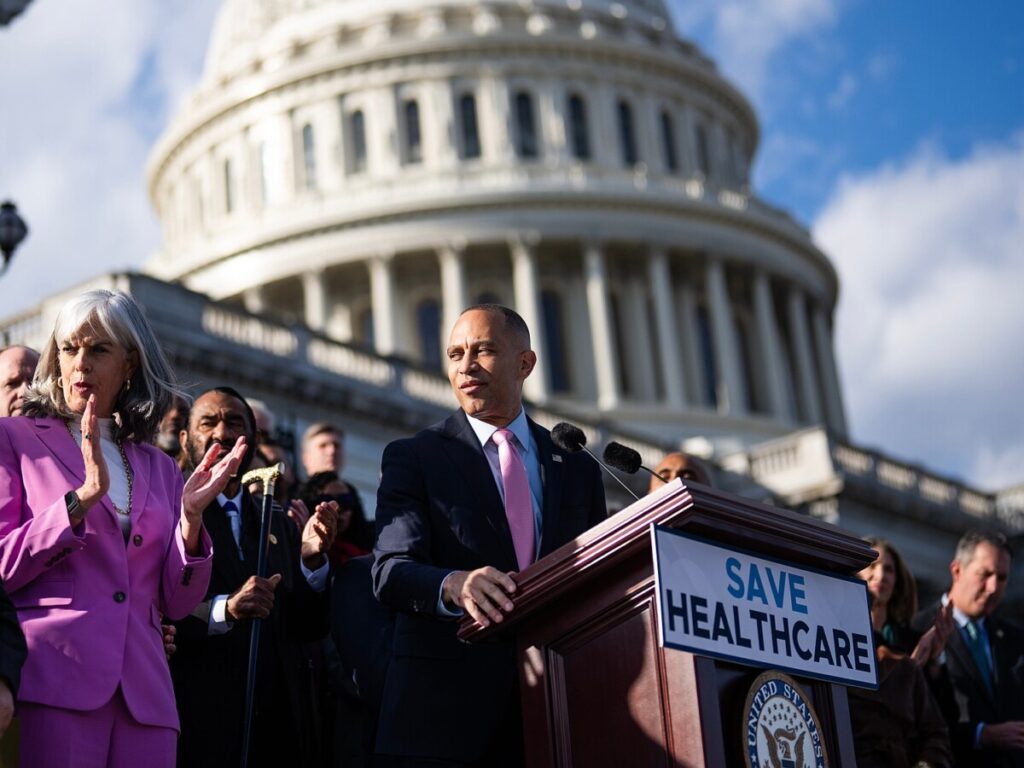Even with the government open, millions of Americans could see their healthcare costs skyrocket
In a recent standoff during the government shutdown, Democratic lawmakers sought to extend enhanced Affordable Care Act (ACA) subsidies but were ultimately unsuccessful, leaving millions of Americans facing potential health insurance premium increases of up to 75% starting in January 2026. These enhanced subsidies, which significantly lower the cost of marketplace health coverage for low- to middle-income households, are set to expire on December 31. With the recent reopening of the government after a prolonged 43-day shutdown, Congress did not reach an agreement on renewing these critical subsidies, which could lead to a resurgence of healthcare costs that many Americans thought were under control. As open enrollment for ACA plans is currently underway, the uncertainty surrounding these subsidies could lead to sticker shock for families seeking health coverage.
The enhanced ACA tax credits, introduced in 2021 under the Biden administration, expanded financial relief for Americans purchasing marketplace plans, allowing more individuals and families to afford health insurance. Enrollment in these plans surged from 11 million to over 24 million over the last decade, largely due to the availability of subsidies for households earning up to 400% of the federal poverty line, which translates to about $128,600 for a family of four. However, without the renewal of these credits, many individuals could see their out-of-pocket premium costs rise dramatically. A recent analysis by the Kaiser Family Foundation indicated that some enrollees might experience an annual premium increase exceeding $1,000, while others could lose their financial assistance altogether. Furthermore, insurers may raise premiums to compensate for expected declines in enrollment among healthier individuals, exacerbating the situation.
In addition to the looming expiration of ACA subsidies, the healthcare landscape is further complicated by the failure to reverse changes to Medicaid initiated during the Trump administration. Proposed reforms, which include new work requirements for Medicaid eligibility and limitations on state funding for the program, could increase out-of-pocket costs for millions of Medicaid recipients, particularly affecting low-income families and those in rural areas. As of mid-2025, approximately 83 million Americans were enrolled in Medicaid and the Children’s Health Insurance Program, and many of these individuals are already living near the federal poverty line. The combination of increased healthcare costs and potential loss of coverage could create significant challenges for vulnerable populations, underscoring the urgent need for legislative action to stabilize healthcare access and affordability in the coming months.
https://www.youtube.com/watch?v=rdVEwEUe948
Democratic lawmakers pushed for an extension of enhanced Affordable Care Act subsidies during the government shutdown but were unsuccesful.
Tom Williams/CQ-Roll Call, Inc via Getty Images
Health insurance premiums could rise by an average of 75% as ACA subsidies expire in December.
Congress failed to extend enhanced Affordable Care Act subsidies during the shutdown debate.
Millions of low- and middle-income Americans may face higher healthcare costs in 2026.
Millions of Americans could see their
health insurance
premiums climb by a staggering average of 75% next year.
Enhanced
Affordable Care Act subsidies
— which lower the cost of marketplace coverage for middle- and low-income households — are set to expire December 31. And, without a healthcare spending agreement from Congress, it’s likely they won’t be renewed. With
open enrollment
underway for those plans, Americans could be facing a new round of insurance sticker shock.
Extending these ACA tax credits has been a key goal of Democrats, contributing to the stalemate at the heart of the recently-ended government shutdown. While the government reopened on November 12 after a record 43 days, lawmakers
failed to take action
on the subsidies, although the deal reopening the government provides for a fresh debate over them next month. They also didn’t reverse President Donald Trump’s
changes to Medicaid
, another goal for Democrats.
For Americans, this all could mean less access to health insurance and higher costs for care.
What to know about ACA and Medicaid in 2026
Low- and middle-income households will feel the brunt of losing enhanced ACA subsidies.
Passed in 2021 under the Biden administration, the expanded tax credits boosted the amount of relief that Americans on marketplace plans could receive. Over the past decade, marketplace enrollment has jumped from 11 to over 24 million. This is partially because the enhanced subsidies were available to middle-income Americans up to 400% of
the poverty line
— which is $128,600 for a family of four — making marketplace plans more affordable.
Without these credits in place, people on ACA plans could see their out-of-pocket premium costs increase by an average of over 75%, a
KFF analysis
shows. Some enrollees would see their financial relief shrink and others would be disqualified entirely, depending on their income, with some premiums increasing by over $1,000 annually. On top of the direct loss of the enhanced subsidies, many insurers are likely to increase premiums to offset a projected decline in enrollment among healthier Americans.
Last year, nearly
20 million Americans
received these enhanced ACA subsidies.
Medicaid recipients
could also see an increase in their healthcare costs. Despite negotiations and the government shutdown, Congress didn’t agree to reverse Trump’s changes to that program from the
One Big Beautiful Bill Act
.
In the legislation, the president called for new Medicaid qualifications that would require non-exempt Americans to work 80 hours a month to qualify for insurance. The law also limits the amount of money states can funnel from
provider taxes
toward Medicaid. This means that hospitals will lose funding and some Medicaid recipients will experience higher
out-of-pocket costs
over the next several years.
Hospitals in rural areas
and low-income Americans are likely to be highly impacted. Most Medicaid recipients live near the federal poverty line, though the exact threshold varies by state. As of mid-2025, about 83 million Americans were enrolled in Medicaid and the Children’s Health Insurance Program.
Have a tip? Reach out to this reporter at allisonkelly@businessinsider.com or via Signal at alliekelly.10
Read the original article on
Business Insider
Eric
Eric is a seasoned journalist covering Business news.



